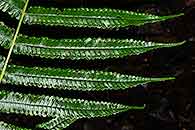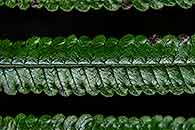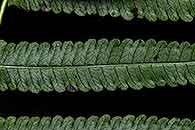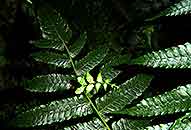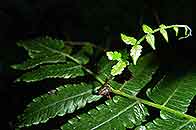Pneumatopteris unita (Kunze) Holttum
Synonyms |
Thelypteris madagascariensis (Fée) Schelpe |
|---|---|
Common name |
|
Description |
Rhizome erect to suberect. Fronds monomorphic, tufted, arching, proliferous on the rhachis near the apex, herbaceous, covered with mucilage when young and coiled. Stipe up to 75 cm long, pale brown, hairless, with a swollen aerophore at the base. Lamina pinnate, ovate-lanceolate to linear-oblong in outline, up to 0.6-1.8 × 0.2-0.5 m, apex with terminal pinna narrowly deltoid, lobed, lower pinnae hardly reduced in size, somewhat deflexed, auricled; pinnae narrowly oblong, 11.5-28 x 1.5-3.3 cm, sessile, base truncate, apex long and abruptly tapering to a point, margin shallowly incised into broadly oblong, rounded, entire lobes with 4-5 pairs of veins meeting below the sinus; undersurface sparsely set with short white hairs on costae, costules and veins, upper surface with sporadic pale hairs; rhachis pale brown, hairless, kinked where the gemmae emerge. Sori round, small, situated close to the costules in the basal half of each lobe; exindusiate. |
Notes | Resembles Ampelopteris prolifera which has a several gemmae positioned along the rhachis, a shortly creeping rhizome and 5-7 pairs of veins meeting below the sinus; this species is not found in evergreen forest.
|
Derivation | unita: united; refers to the several pairs of veins which meet (anostomose)below the sinus between adjacent pinna lobes. |
Habitat | Seepage zones along streams or moist floors in shade in high-rainfall, evergreen forest. |
Distribution worldwide | |
Distribution in Africa |
Burundi, Cameroon, Dem. Republic of Congo, Equatorial Guinea (incl. Bioko), Ethiopia, Kenya, Liberia, Malawi, Mozambique, Rwanda, South Africa, Sudan and South Sudan, Swaziland, Tanzania , Uganda, Zambia, Zimbabwe. |
Growth form |
Terrestrial. |
Literature |
|


